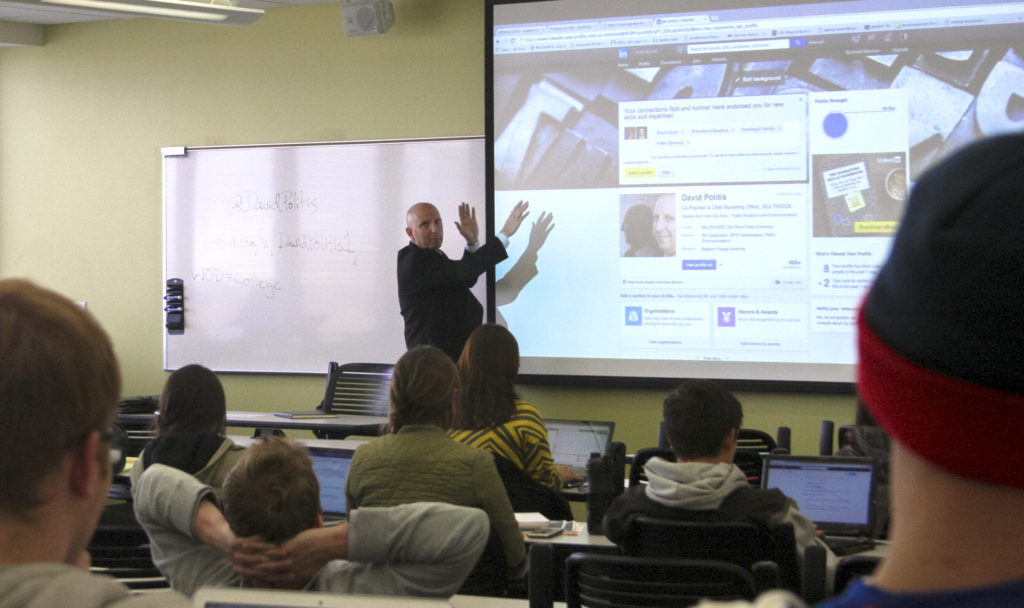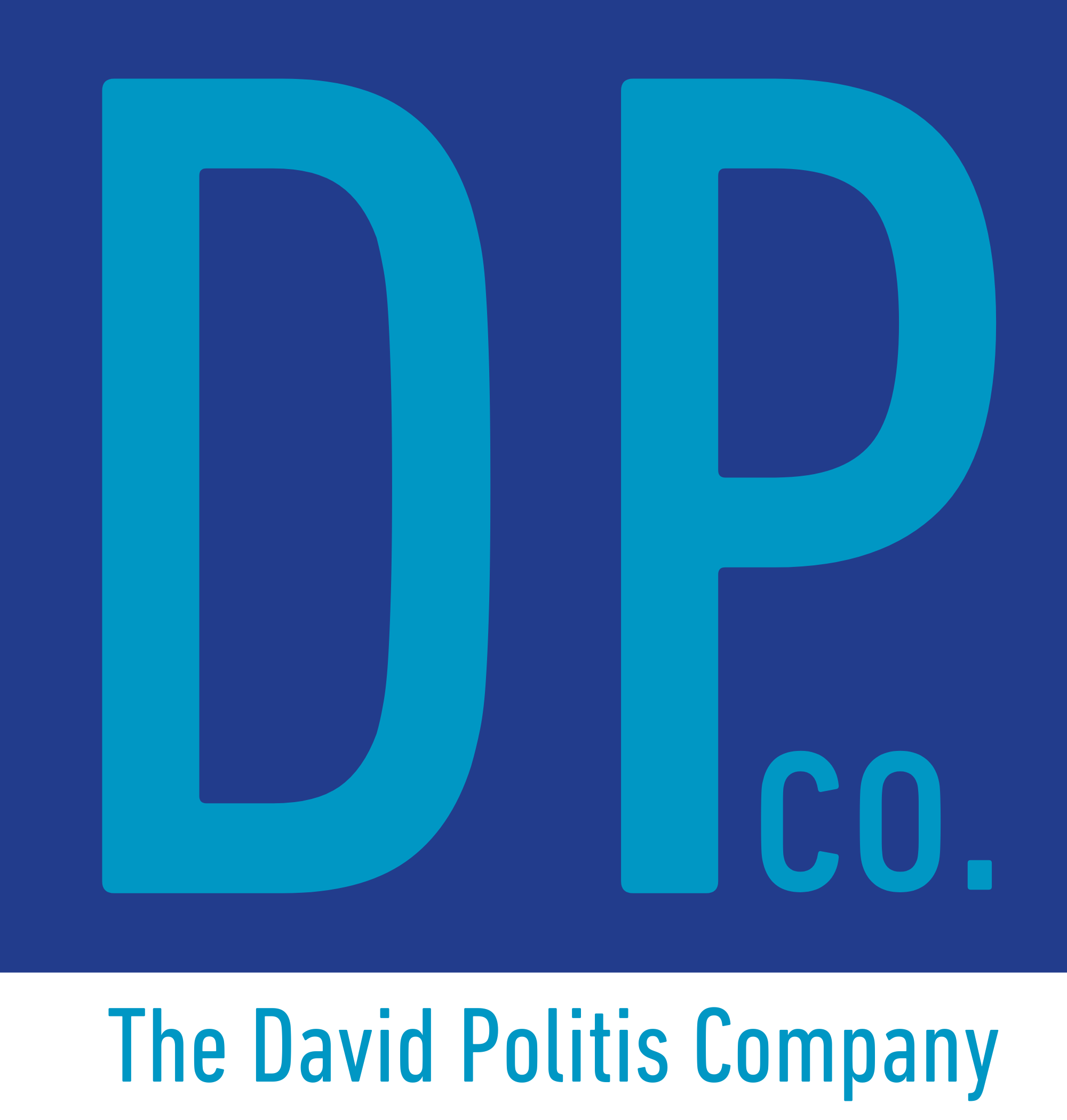12 Sep Eleven Lessons Learned from 5-1/2 Years as a CMO
After serving for the past five-and-a-half years as the Chief Marketing Officer for two separate technology startups, I recently made the difficult decision to transition back into full-time consulting.
Here’s my list of 11 lessons learned while working as CMO, as well as some thoughts on what I hope to accomplish as I return to the world of full-time consulting.

Marketing consultant, David Politis, teaching students the critical aspects of a great LinkedIn Profile.
BRIEF BACKGROUND
In case you don’t know me, I’ve got 30-plus years under my belt in the worlds of Publicity, Public Relations, Investor Relations, Marketing, Advertising, Social Media, Event Management and more (including Sales). The vast majority of that time has been spent on the consulting side of the fence (27+ years to be exact), starting in the heart of Silicon Valley, then in Seattle, and finally in what is now known as Silicon Slopes (or Utah, for the uninitiated).
During my career I’ve worked with firms on three continents, serving companies as large as GTE (now part of Verizon), SANYO, Apple, and Schwinn to small, brand-new startups with only a few founders on their teams. And my focus has always been helping firms drive action in the marketplace (having produced over $300 million in sales leads) so those companies can boost their value in the process (in real terms, my clients/employers have experienced a combined valuation increase of over $1.1 billion during my career).
Following a very successful PR campaign near the tail-end of the Great Recession, I had a client ask me to join their firm as employee #4 as its CMO, a position I held for nearly four years as I helped that company grow to over 100 employees. I then joined a friend at a different startup as CMO and Co-Founder, a position I filled for ~18 months.
LESSONS LEARNED
1. You Don’t Know What You Don’t Know.
The great benefit of working as a consultant is that you get to experience lots of things across lots of companies, all at the same time. In other words, your breadth can get very, very wide very, very quickly. It’s one of the reasons why I think everyone working in a marketing discipline can benefit from working inside an agency … at least for awhile.
Conversely, the opposite is also more likely to be true inside of an organization. Specifically, the potential exists inside a firm to get very, very deep into every aspect of that company, its market(s), products, services, customers, partners, investors, etc. While this potential is especially true within a startup, it is less so inside an established company, unless (of course) that established firm is led by an inspired individual who understands the value of cross-pollination within an organization.
And although I mentally grasped this key difference between corporate work vs. consulting work, I could not appreciate the value that working inside a corporation could bring to me until I experienced it for myself. Simply put, I didn’t know what I didn’t know.
As a result, I’ve now broadened my horizons into product design and development, dove deep into market analysis and financial projections, recruited, signed and worked with channel partners on a daily basis, and undertaken many other marketing endeavors I did not understand (or know) on a first-hand basis.
2. Face-to-Face Still Matters. A Lot.
No question about it. Technological advances help companies do almost everything digitally, from selling products and services to holding virtual meetings with teams of people at locations scattered around the globe.
Best-selling author John Naisbitt foresaw this day as one of 10 world-shaping Megatrends in his 1984 book of the same name. In fact, he named it his No. 2 Megatrend — Forced Technology: High-Tech/High-Touch.
In simplest terms, Naisbitt foresaw a day when technology would make it possible to conduct even the most basic of human and organizational tasks using technology, a prognostication that is hard to argue against today. However, as an extension of his predicted technological advancements, Naisbitt also suggested that such technology breakthroughs would increase the emotional and psychological need for human interaction:
- shaking someone’s hand,
- giving a literal pat-on-the-back, or
- sitting across from someone, face-to-face.
To me, this is one of the reasons why I still recommend companies find opportunities to participate in trade shows, exhibitions and industry conferences. Somethings, I believe, still require that personal touch.
3. It Always Takes Longer (And Costs More) Than Expected.
After three decades of working with companies funded by outside investors and venture capitalists (especially high-tech and biotech companies), I’ve come to learn that most inventors tend to be optimists — which is great. Unless they’re making projections on how long it will take to complete the next iteration of their unique doodad or the next section of code. And then it’s a problem, potentially a REAL problem.
Honest angel investors and VCs will tell entrepreneurs and business owners that on average it takes twice as long and twice as much money to get something to market as most entrepreneurs think it will take. And my experience is that they’re correct.
Unfortunately, I learned that lesson the hard way at both startups where I served as CMO.
4. Track Almost Everything. Adjust Accordingly.
One of the great things about the advent of cloud-based computing and software is the ability to capture, manage and analyze data in real-time about almost anything. Unfortunately, not all data is the same, while the amount and speed at which it proliferates continue to accelerate.
The three-dimensionality of such BIG DATA — Variability, Volume and Velocity, aka, V-cubed (or V3) — can make it difficult for entrepreneurs and small-business executives to be able to capture (let alone analyze and understand) the implications of such data streams and troves. Thankfully, there is a large and growing set of tools and service providers that have emerged specifically to address these issues, chief among them Microsoft, Qlik, and Tableau (at least according to the Gartner’s 2016 Magic Quadrant for Business Intelligence and Analytics Platforms report).
Whether you decide to jump on the Business Intelligence (BI) bandwagon now or not, the reality is that you are probably tracking and analyzing certain datasets already, from
- Customer data to Channel partner data, and from
- To Cashflow data to Employee data,
and beyond.
The critical concept, therefore, is identifying what data will provide you with the best information for making the right decisions at the right time. And that’s where I start any data analysis undertaking, whether I’m working as a consultant or inside a company.
5. Speed Trumps Perfection (Unless Perfection Trumps Speed).
One of my bosses (when I was serving as Chief Marketing Officer) insisted that everything be done perfectly, and I agreed with him — up to a point.
Clearly, one miswritten line of code can foul-up an entire software application, while 1/10th of a millimeter in variation may prove to be too much tolerance in a finely tooled machine part. The same can also be said for financial figures and tables submitted for an auditor’s review or for a finely crafted press release about the terms and conditions of a newly signed contract.
Conversely, there are also times when the best you can do is often the best thing to do.
The best you can do is often the best thing to do.
In other words, there are times when the most important act is finishing something and getting it out the door, even if it isn’t perfect when you’re finished. Not that perfection isn’t something to strive for; that’s not what I’m suggesting at all.
In fact, one of my personal heroes talks about understanding the distinction between
- Good and Better, and between
- Better and Best.
I now believe that there are instances when Good Enough is in fact Good Enough. In fact, if Time to Market (aka, speed) is the governing factor in your decision-making process, then Good Enough is often the only path to follow.
6. Assume Nothing. Expect Anything.
Just because someone is an expert in a given field, do not assume that she or he will always do excellent or expert-level work. Conversely, just because you would do something because it is just obvious it is the right path to follow, do not assume others will feel or act the same way you feel or act.
Similarly, even if all indications lead one to believe that someone else is trustworthy and will “do the right thing,” such a premise is not always so.
In modern times, President Ronald Reagan apparently adopted the Russian proverb “Doveryai, no proveryai” when negotiating with the former Soviet Union. Roughly translated it means
Trust, but verify.
Transposed into action, expect people (and businesses) to do anything, even things that are counterintuitive or contrary to what they have said (or done) in the past. It’s the prudent approach.
{NOTE: I get that this is a really negative viewpoint, which is typically contrary to my way of thinking. But recent events have led me to this recognition, especially when it comes to business dealings.}
7. Integrity Is Everything.
It used to be that if someone made a promise, that promise was kept.
It’s not that way any more, at least not in every environment. But it should be.
The same holds for telling the truth. Call me naive if you’d like, that’s fine.
But in these final weeks leading up to the first Tuesday in November, I think it’s clear that American citizens are disgusted with the prospect of electing someone they don’t feel they can trust as the next President of the United States.
Trust. I think that’s the root of the word Americans are looking for in the person they elect as the head of the free world, someone who they believe will be …
Trustworthy.
And that, my friends, represents a sad state of affairs for the U.S. of A.
8. Control What You Can Control.
This month marks 15 years since terrorists struck America on September 11, 2001, attacking the Pentagon, destroying the Twin Towers in New York City, and killing nearly 3,000 people in the process.
Now this may seem a bit incongruent at first, but stick with me — this will make sense in a moment.
I am not opposed to people learning or growing or changing directions or careers. Nevertheless, I believe that the best pathway to success is often achieved by sticking to what one knows the best. In essence,
Focus is the ONLY path to excellence.
Whether I’m working with companies as a consultant or as an executive officer for a firm, my goal is to “stay in my lane” (aka, do what I do best) so I can control what I can control. And that’s what I do, unless asked by the boss or a client to change focus or directions.
Nevertheless, there are times when people, organizations or forces outside my control come into play. And it is in those instances when you must . . .
9. Expect the Unexpected.
A good friend of mine is a retired FBI agent. And she explains that the Bureau has been running What-If scenarios on terrorist attacks for decades.
Clearly, such brainstorming and planning did not prevent the horrific attacks of 9-11 on American soil. But, she asked rhetorically, how do I know they haven’t prevented countless other terrorist attacks throughout the U.S.? And then she clammed up (which was fine).
From a marketing standpoint, the wise executive recognizes that unexpected things happen. And in some instances, some unexpected events actually take on crisis proportions.
That’s why smart execs and marketing / communications professionals create Crisis Communications Programs that allow their organizations to address, weather and survive unexpected events and situations.
10. Life Happens.
As an example of expecting the unexpected, I only have to return in my mind to July 3, 2015 at 8:22 a.m. That was when I learned that my friend and the President of our tech startup, Todd Rapier, had died in his sleep the night before.
Turns out he had an enlarged heart, as well as a 90 percent occluded (blocked) major vein feeding his heart. None of us knew, Todd included. He was 45-years-old at the time.
Obviously it was a major shock, both personally and professionally.
Yes, life often takes unexpected and transformational twists and turns. Thankfully, our executive team had enough years under our collective belts that we were able to navigate the near-term storm associated with such a rocky event.
But to be clear, there are reasons why individuals and families should have Life Insurance policies in place, as well as current Wills / Trusts in order and executed properly. Conversely, on the business side of things, although it’s difficult to do, executive teams should discuss possible succession plans in case of an unexpected illness or death. Likewise, Key Man insurance policies should be also considered, and yes, even Crisis Communications Plans (as noted in Item No. 9 above), because unfortunately, life just happens.
11. Clear Objectives + Resources + Freedom = Outstanding Results.
Last of all (though not the least important lesson learned from my time as a Chief Marketing Officer), I share this last lesson.
Specifically, if your overall objectives are clearly defined so that all team members know what the organization is trying to achieve, and then adequate resources are provided along with the freedom to achieve said objectives, success is virtually guaranteed.
That’s assuming, of course, that you have the right people in place and that they are properly trained, led and motivated.
But all other items considered, outstanding results should be your outcome.
I get that this may sound overly simplistic. But my experience and years of personal research have supported this lesson again and again. Specifically,
Clear objectives,
+ The right people in the right positions,
+ Adequate resources,
+ The freedom to work,
+ Proper training and leadership
Success (again and again).
And yes, I believe that the path for success really is that straightforward.
MOVING FORWARD
Now that I’m back in the world of consulting, how do these lessons apply to me in my role as professional consultant versus my recent positions as Chief Marketing Officer?
First off, events of the past half decade have reaffirmed my resolve to make a difference in the world, as well as the realization that sometimes helping my clients make a difference is the best thing I can do, both for them and for society as a whole.
Secondly, life is precious (as shown not just by the unexpected loss of Todd slightly more than a year ago, but also by the passing of my mom last year too).
So to me, I have strengthened my belief in the paramount importance of relationships. And if relationships are paramount, then integrity, trustworthiness and truthfulness are close behind as supporting bulwarks to one’s personal and professional relationships.
Last of all, while trying to be both realistic and trying to avoid the cynicism trap, I believe that most people are good — individuals doing the best they can while struggling with challenges that most of us will never fully know or appreciate. And from that perspective, I’m doing my best to try and cut others a bit more slack, while striving to be more patient and understanding, all within the overall objective of being as successful and impactful as I can in everything I do.
That’s what I’ve learned from being a Chief Marketing Officer for the past five-and-a-half years. How ’bout you?
# # #
I LOOK FORWARD TO HEARING WHAT LESSONS YOU’VE LEARNED RECENTLY, EITHER PROFESSIONALLY OR PERSONALLY. THANKS.


No Comments